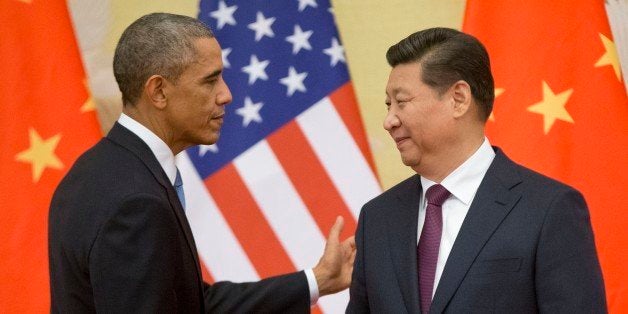
President Obama's historic agreement Wednesday with President Xi Jinping of China is the kind of bold action needed to reinvigorate the world's efforts to slow and eventually reverse climate pollution.
The president has opened the door to success with a global climate agreement in Paris next December. His climate leadership just might save the world from the most severe climate impacts before they become irreversible.
President Obama announced today that the U.S. would cut climate pollutants by 26-28 percent below 2005 levels by 2025. President Xi Jinping of China announced that China's CO2 pollution would peak around 2030, and possibly earlier, and that the country will increase its share of non-fossil fuel energy to around 20 percent by that date.
The US-China agreement has the three key elements needed to put the planet on a path to climate safety: fast action to cut short-lived climate pollutant starting with hydrofluorocarbons, or HFCs, fast action to cut carbon dioxide emissions, the main long-lived climate pollutant, and the beginning of action to manage carbon dioxide after it has been emitted, through an ambitious plan to develop carbon capture, utilization, and storage (CCUS), for example by capturing carbon dioxide at the smoke stack and turning it into cement-like building material.
President Obama understands the need to build political momentum at the global level to bring out the "A game" of the other large emitters, and this agreement between the number one and number two leading climate polluters will help do that. The president's leadership started at home, and this gave him the renewed credibility needed to return to the global stage as a climate leader.
For the past two years President Obama has been leading the global effort to control hydrofluorocarbons, or HFCs, under the Montreal Protocol, the world's most successful climate treaty. The US-China cooperation has been the cornerstone of the President Obama's efforts, starting with the first meeting between the two leaders in Sunnylands, California in June of last year, which resulted in two agreements: one to cooperate on North Korea, the other to work together to reduce HFCs.
The leadership on the HFC amendment by President Obama and President Xi sets the stage to conclude the biggest, fastest piece of climate mitigation available to the world in the near-term in advance of the UN climate negotiations in Paris next December, which aim to conclude a broad-based global climate agreement. Controlling HFCs can provide ten to twelve percent of the climate mitigation the world needs to keep the climate within safe bounds. The total climate benefit will be significantly more when the calculations include the expected improvements in energy efficiency of air conditioners and other appliances using HFCs, as these improvements will reduce CO2 emissions from the power plants that provide the electricity to run the appliances. In India alone, Lawrence Berkeley Energy Lab calculates that moving to super-efficient air conditioning could avoid building up to 120 medium-sized power plants by 2030. Air conditioning uses half or more of all electricity in hot countries during the peak season.
President Obama, who reached an HFC agreement with Prime Minister Modi of India during the PM's White House visit at the end of September, understands that the road to Paris now goes through Montreal. The annual meeting of the parties to the Montreal Protocol is next week in Paris.
Key language from the White House Fact Sheet on CCUS and HFCs follows:
•Advance Major Carbon Capture, Use and Storage Demonstrations: Expanding our work under the Climate Change Working Group (CCWG) and under the CERC, and partnering with the private sector, the United States and China will undertake a major carbon capture and storage project in China that supports a long term, detailed assessment of full-scale sequestration in a suitable, secure underground geologic reservoir. The United States and China will make equal funding commitments to the project and will seek additional funding commitments from other countries and the private sector. In addition, both sides will work to manage climate change by demonstrating a new frontier for CO2 use through a carbon capture, use, and sequestration (CCUS) project that will capture and store CO2 while producing fresh water, thus demonstrating power generation as a net producer of water instead of a water consumer. This CCUS project with Enhanced Water Recovery will eventually inject about 1 million tons of CO2 and create approximately 1.4 million cubic meters of freshwater per year.
•Enhance Cooperation on Hydroflurocarbons (HFCs): Building on the historic Sunnylands agreement between President Xi and President Obama regarding HFCs, the United States and China will enhance bilateral cooperation to begin phasing down the use of high global warming potential HFCs, including through technical cooperation on domestic measures to promote HFC alternatives and to transition government procurement toward climate-friendly refrigerants.
